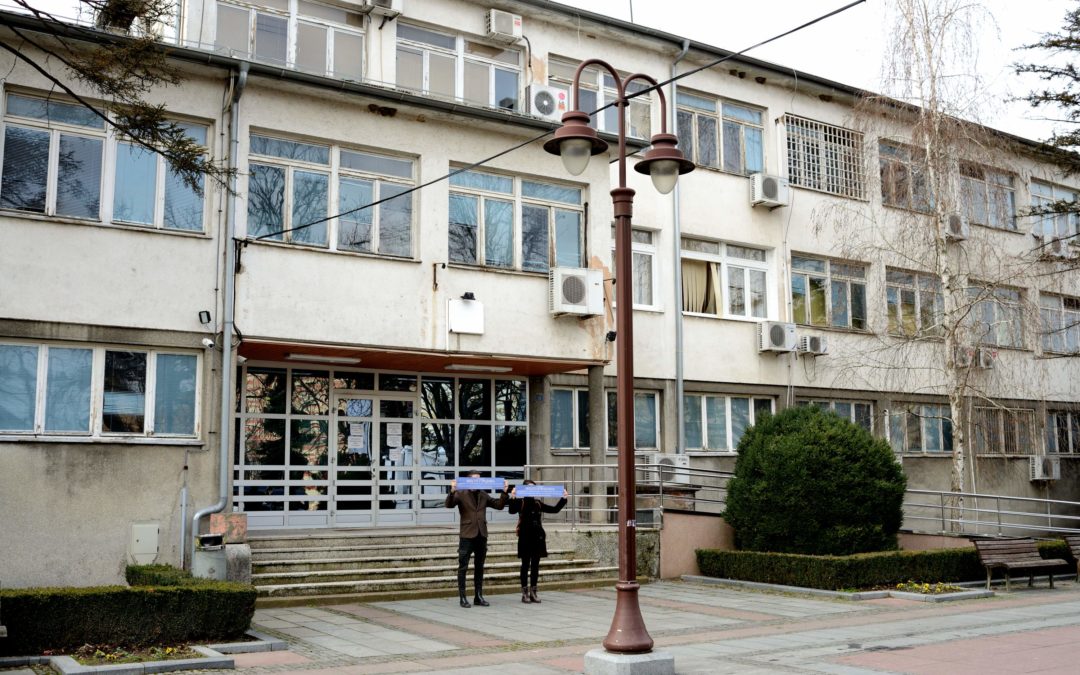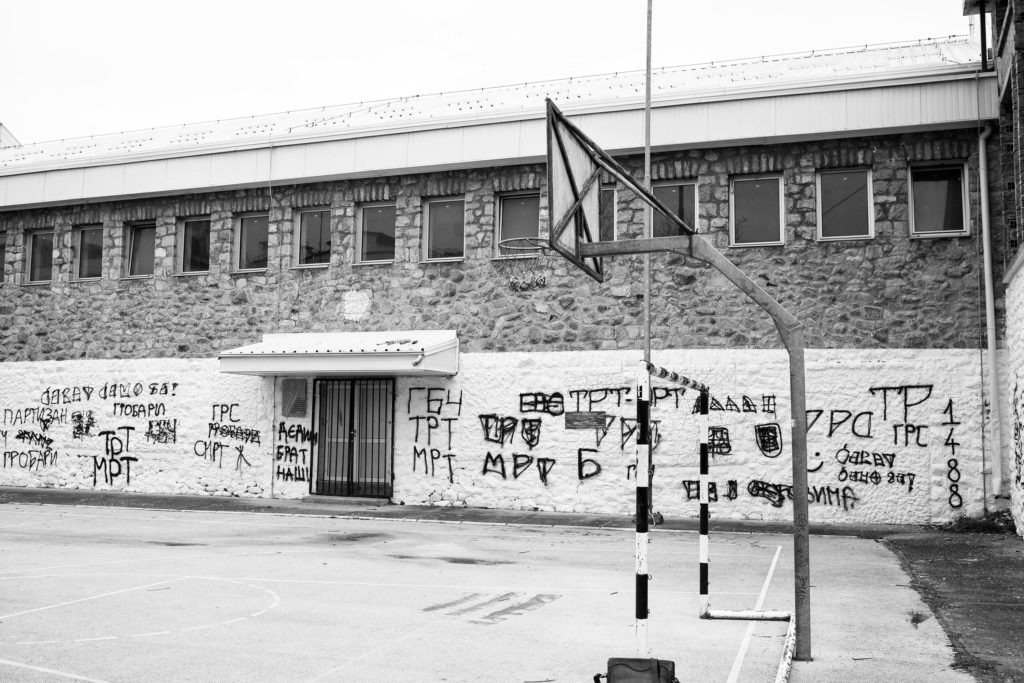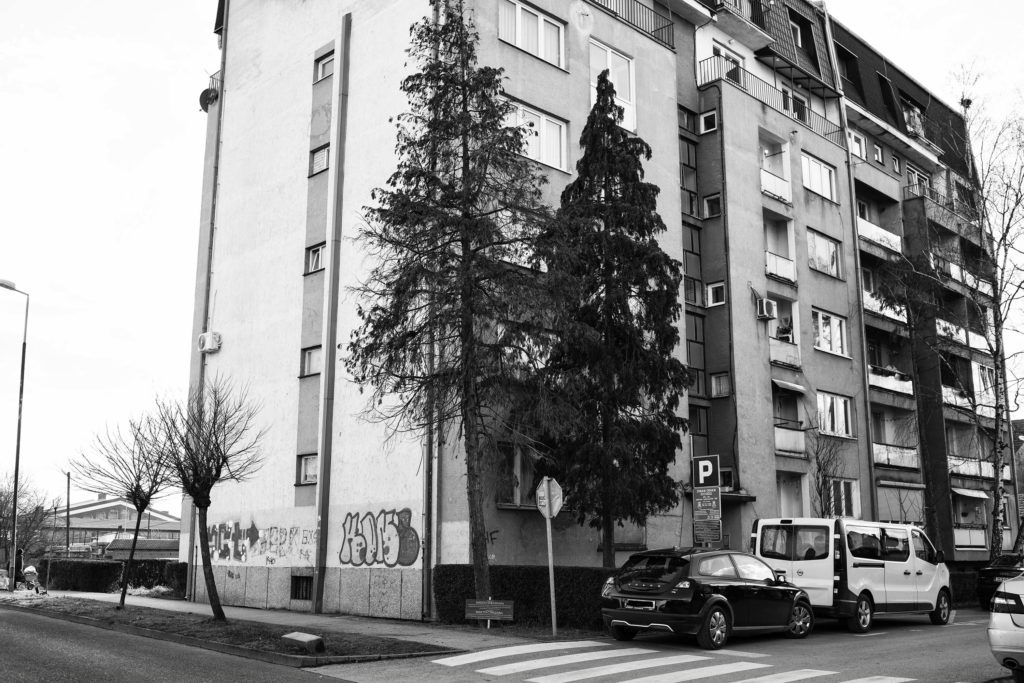The 18th action to mark unmarked sites of suffering (ONMS) was carried out in February 2022 in the Brčko District of BiH.
We marked seven locations: the former Partizan Sports Hall, the former Posavina Hotel, the Public Security Station (SJB) building, the site where two boys were killed in the residential settlement of Novo Brčko, the Primary School in Gornji Rahić, the former Rasadnik refrigeration facility in Okrajci, and the former Laser Bus Company. If we add to this the sites marked during our previous ONMS action: the construction materials warehouse in Gornji Zovik, the Boće Primary School, and the former JNA barracks, as well as the other sites of suffering in Brčko: the bridge over the Sava, the Luka camp, Hadži-Pašina Mosque, the Brčko Hospital… it makes for a long but unfortunately not a final list of sites of suffering in Brčko.
The list is too long for a whole eternity, and not just the few years it spans; it is too long for a whole planet, and not just a small Bosnian town. If, according to Agamben, we know that the “camp is merely the place in which the most absolute conditio inhumana (inhumane situation) that has ever existed on earth was realized: this is what counts in the last analysis, for the victims as for those who come after,” then we could say for Brčko in the war years of 1992-1995 that it was exactly that, an (un)place, a town-camp.
“The days of war in Brčko were very difficult, especially the detention of many Bosniaks and Croats in this city, at various locations. There was widespread abuse, rape, killings at all the detention facilities. I think there were some 15 such facilities across Brčko, all of them were later closed and most of the prisoners were transferred to the Luka camp. Today, only Luka is marked as a site of suffering, but none of the other places are,” said Amir Didić, a prison camp survivor and president of the Brčko Association of Prison Camp Survivors, who joined us in marking the sites of suffering.
Vow of Silence
Brčko features a selective approach to victims, mostly based on their ethnicity or more often on the ethnicity of the those who committed the atrocities, and aided by fear or shame, it is deeply unjust and constrictive. There are dozens of sites of suffering in the city, mostly unmarked and either unknown or not spoken about. A vow of silence. Selectivity and injustice thus become deeper, the pain greater, and trust and reconciliation further out of reach. Our primary aim is to send a message of solidarity and empathy for the victims and their families. With ONMS actions, we are raising awareness in local communities about the existence of such sites, places where their neighbours were killed, their fellow citizens, and our aim is to make sure that the places, events and people are not forgotten.
This time, our ONMS action was joined by Vanja Stokić, a reporter and editor at the E-trafika portal, and you can read her impressions from Brčko here: https://www.etrafika.net/drustvo/85168/sjecanje-je-ujedno-i-opomena/
For Vanja, even though she is a native of Brčko, this was the first time she heard of some of the sites we marked. One of them, the Partizan Sports Hall, where she played volleyball as a girl, was a site of detention in May 1992 for some 50 Bosniaks and Croats from the Brčko area. Five people were killed there. The Partizan Sports Hall is still used today as a sports facility. Although flowers are laid at the site each year in commemoration, there is no permanent memorial.
Vanja, like most residents of Brčko, had never before heard about the site where two boys were killed in the residential settlement of Novo Brčko. As they were playing in front of the building where they lived, a missile fired from a multiple rocket launcher situated across the Sava hit the small park and killed Nenad Stolić and Siniša Ješić, boys of 12 and 14. In contrast to how we learned about most of the sites we marked, from court documents, trials, judgements, etc., this time the invitation to visit and mark the site came from ordinary citizens.
“We learned about this site from citizens who reached out to us and told us what happened there. A friend of the family of one of the boys who were killed contacted us through our website. We then got in touch with the brother of the boy who was killed and he told us about what happened. We would like to encourage other citizens to reach out to us, because we know that in Bosnia and Herzegovina, there are hundreds of sites like this that remain outside the existing culture of memory. Competent authorities should be petitioned to mark this site and place a memorial there, some sign of memory,” said Amer Delić, a peace activist and member of the ONMS Team.
Having a memorial, some proof that the victim has not been forgotten would mean a lot to the families of the boys who were killed. Even our action, however modest, provided a sense of comfort and support.
“Of course, it means a lot, these things should be preserved from oblivion. Some might say we’re going back into the past, but still, it’s nice to know that someone remembered to mark this site, so it’s not forgotten, so something like this never happens to anyone again.” said Predrag Stolić, brother of Nenad and friend of Siniša, the two boys that were killed at the site.
Indifference feeds a new evil
The Posavina Hotel and the Public Security Station (SJB) in Brčko were used in 1992 as sites of detention for Bosniaks and Croats from the Brčko area. Both buildings are in the very centre of town, in the pedestrian zone, without any permanent sign or memorial plaque
The Primary School in Gornji Rahić near Brčko was used from 14 September 1992 to 4 March 1993 as a detention facility for Serb prisoners of war and civilians, as was the Rasadnik refrigeration facility in Okrajci in Gornji Rahić from May to June 1992. The Laser Bus Company in Brčko was used from 4 to 10 May 1992 as a detention site for Bosniak and Croat civilians from the Brčko area.
All the sites have mostly been restored to their original purpose: children go to classes at the school building, the police station is now used by the Brčko District police, volleyball is still played at the sports hall, there are children playing in the little park in front of the residential building, and the bus company is a commercial building again… Life goes on, you might think, walking down the Boulevard of Peace where you will pass by three monuments. All three were erected to honour the defenders of Brčko, its Serb, Bosniak, and Croat defenders. Sometimes life is surprisingly callous in its indifference. And it is precisely this indifference, this obliviousness, this denial, this escape into the ease of forgetting and keeping silent, that is perhaps feeding a new evil, new wars, new camps.
We were shown to all the sites by Sead Golić, secretary of the Association of Families of Missing, Forcibly Removed and Killed Bosniaks of the Brčko District of BiH. Without a trace of fear that his actions could have unwanted consequences, Sead kept repeating that he had nothing to fear, and neither did we while we were with him. “My honour is untainted,” he kept repeating during the action. It was our hosts that showed us that we were not alone in fighting against indifference and the callousness it breeds. In both their words and actions. By coming with us to mark the sites and by unequivocally saying:
“It would be very important to mount a plaque, something symbolic, for history to be known, in aid of reconciliation on all sides, not just the Bosniak and Croat, but also the Serb side, wherever someone was detained, for it to be known, to be marked. In my opinion, this would contribute to much better coexistence. For all of us to mark these sites together, all three peoples, for all of us to mark these significant dates and sites together,” said Amir Didić, a prison camp survivor and president of the Association of Prison Camp Survivors from Brčko.
“I think this should be done in every town, all the actual places should be marked, wherever they are, wherever Serbs or Bosniaks or Croats were killed or detained, because only then can we reach the truth. All these places should be marked, even sites of individual deaths, where one person was killed, because one life is worth more than anything else in the world. There will probably come a time when we will be able to come to a site together, in humility, to pay our respects to these people, to remember the people who were killed or detained, on all three sides,” Sead Golić said.
These words also confirm to us that things are changing for the better. From the initial denial that a crime took place, and then calls to mark only the sites where members of my own ethnicity or nationality suffered, because only we are the victims, we have slowly arrived at a point where people are calling for the sites of suffering of the “others” to be marked. Calling for all of us to do this together!
As Agamben’s thought on camps “…this is what counts in the last analysis, for the victims as for those who come after” echoes, so does the desire to make sure those who come after will never be subjected to such conditio inhumana. It is a desire to finally break off that long list from the beginning, to end it, seal it. Not by forgetting or neglecting it, but by marking it and having it stand as a warning. We have to start by recognising that the atrocities happened and that these sites of suffering exist, that they are here, in our towns, our villages, our streets… among us. Then we must make sure that these facts and memories are not misused to demonise others or to mobilise for a new war. And finally, or rather never, we should never stop fighting against evil and its chances of being repeated.
Video from the action:



